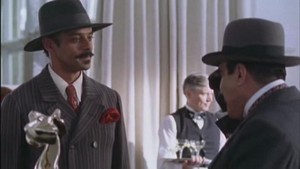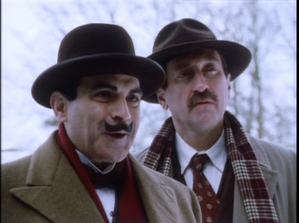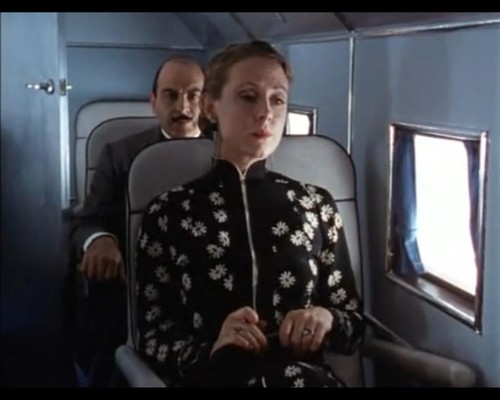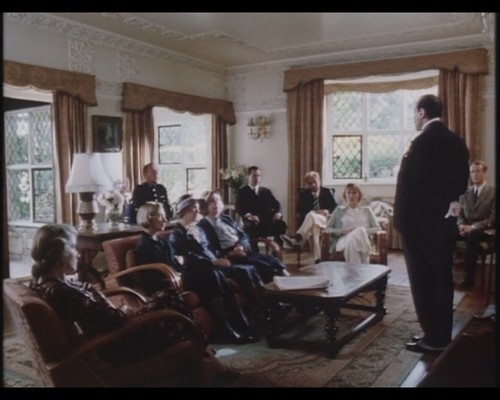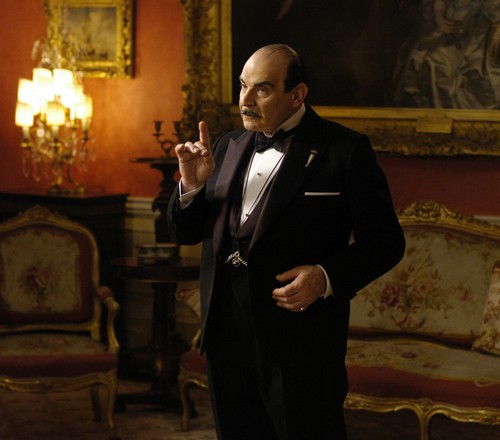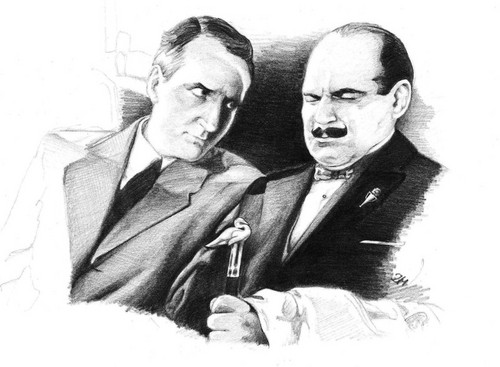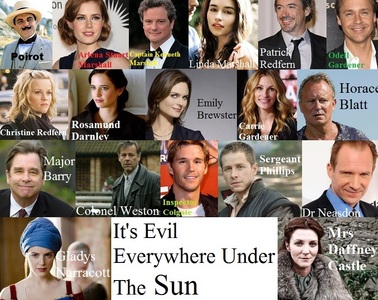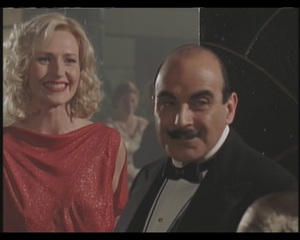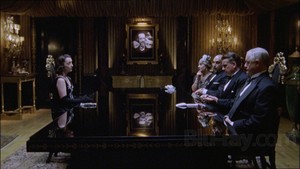"DEATH ON THE NILE" (2004) Review
This 2004 adaptation of Agatha Christie’s 1937 novel, "Death on the Nile", was the second to be adapted for the screen. In the case of this movie, it aired as a 90-minute presentation on the long-running television series, "Agatha Christie’s POIROT".
Like the novel and the 1978 movie, "DEATH ON THE NILE" centered around Hercule Poirot’s investigation of the murder of an Anglo-American heiress named Linnet Ridgeway. Linnet had stolen the affections of her best friend’s fiancé and married him. When the newly married couple vacationed in Egypt, the best friend – one Jacqueline de Bellefort – stalked and harassed them during their honeymoon. Yet, when Linnet and her new husband, Simon Doyle, boarded the S.S. Karnak for a steamboat cruise down the Nile River, the heiress discovered she had other enemies that included the offspring of a man whom her father had financially ruined, her embezzling attorney who required her signature on a paper or her death to hide his crimes, a kleptomaniac American socialite and a professional thief who was after her pearls. Unfortunately for the killer, a vacationing Hercule Poirot and his friend, Colonel Race, are on hand to solve Linnet’s murder.
There were aspects of this adaptation of ”DEATH ON THE NILE” that I found admirable. The movie’s set designs for the S.S. Karnak seemed bigger and slightly more luxuriant that what was shown in the 1978 movie. Production designer Michael Pickwoad did a first-rate job in creating the luxurious atmosphere for the 1930s upper class. Actor J.J. Feild gave a solid performance as Simon Doyle, the man who came between Linnet Ridgeway and Jacqueline de Bellefort. However, I do not think he managed to capture the literary Simon Doyle’s boyish simplicity and lack of intelligence. I also enjoyed Frances La Tour’s portrayal of the alcoholic novelist, Salome Otterbourne. She gave her performance a slight twist in which her character seemed to be a little hot under the collar as she makes sexual advances toward Poirot in a subtle, yet comic manner. And the movie’s one true bright spot was, of course, David Suchet as Hercule Poirot. As usual, he gave an exceptional performance. However, I noticed that he was never able to form any real chemistry with James Fox’s Colonel Race or Emma Griffiths Malin, who portrayed Jacqueline de Bellefort; as Peter Ustinov had done with David Niven and Mia Farrow, respectively.
I wish I could harbor a high opinion of "DEATH ON THE NILE". But I cannot. There were too many aspects of this production that rubbed me the wrong way. I noticed that this version adhered very closely to Christie’s novel. Unfortunately, the screenplay’s close adaptation did not help the movie very much. It still failed to be superior or just as good as the 1978 version. So much for the argument that a movie has to closely follow its literary source in order for it to be any good. A closer adaptation of Christie’s novel meant that characters missing from the 1978 version – Cornelia Robson, Marie Van Schuyler’s clumsy young cousin; society jewel thief Tim Allerton; the ladylike Mrs. Allerton and the Allertons’ cousin, Joanna Southwood – appeared in this movie. Only the Italian archeologist, Mr. Richetti and Jim Fanthorp, the British attorney were missing. And honestly, the presence of the Allertons, Cornelia Robson and Joanna Southwood added nothing to the story as far as I am concerned.
Aside from a few members of the cast, the acting in this movie struck me as very unexceptional and a little hammy at times. You know . . . the kind of hamminess that makes one wince, instead of chuckle with amusement. However, I failed to be amused by Emily Blunt's portrayal of Linnet Doyle. One, I found her American accent to be atrocious. And her Linnet did not strike me as autocratic. Only spoiled and self-indulged. Perhaps this change in personality was an excuse to include a scene featuring Linnet snorting heroin. There were other performances that I found particularly off-putting. Zoe Telford's portrayal of Rosalie Otterbourne struck me as over-the-top as her physical appearance. I got the feeling that Telford was trying just a tad too hard with the hardened "Bright Young Thing" image. As for Daniel Lapaine's portrayal of Tim Allerton . . . what in the hell was that? I realize that Tim was supposed to be a slightly weak character, but Lapaine portrayed him as some clichéd effeminate fop from the early 20th century . . . but with incestuous overtones.
There were other problems I had with the movie. Exactly when is this particular movie set? Poirot and Race discovered that Andrew Pennington possessed a ticket for the famous French ocean liner, the S.S. Normandie. Yet, according to another character, Jim Ferguson, a madman had just taken control of Germany. If he was referring to Adolf Hitler, then screenwriter Kevin Elyot had created an anachronism. Hitler took official control of Germany over two years before the Normandie had set sailed on its maiden voyage. Also, by closely following Christie's novel, Elyot repeated the author's mistake with a revelation that there were more characters that did not have a real grudge against Linnet Doyle than there were who did. And I also wish that Elyot had allowed Poirot to reveal the murderer in front of the other characters, instead of only four of them.
But the movie’s real atrocities came from the hairstyles and makeup created for the younger actresses in the cast. Most of the hairstyles seemed like sloppy re-creations of those from the mid-1930s, the worst offenders being the cheap-looking blond wig worn by Emily Blunt (Linnet Ridgeway Doyle), the butch hairstyle worn by Telford; and the gaudy makeup worn by all of the younger actresses. Only Daisy Donovan, who portrayed Cornelia Robson was spared from resembling a kewpie doll. Instead, she wore a sloppy bun that served as a metaphor for her insecure personality – a theatrical maneuver that I found unnecessary.
I hate to say this but despite David Suchet’s performance as Poirot and Michael Pokewoad’s production designs, I came away feeling less than impressed by this version of "DEATH ON THE NILE". Not only did I find it inferior to the 1978 version, but also to many other adaptations of Agatha Christie’s novels and stories.
This 2004 adaptation of Agatha Christie’s 1937 novel, "Death on the Nile", was the second to be adapted for the screen. In the case of this movie, it aired as a 90-minute presentation on the long-running television series, "Agatha Christie’s POIROT".
Like the novel and the 1978 movie, "DEATH ON THE NILE" centered around Hercule Poirot’s investigation of the murder of an Anglo-American heiress named Linnet Ridgeway. Linnet had stolen the affections of her best friend’s fiancé and married him. When the newly married couple vacationed in Egypt, the best friend – one Jacqueline de Bellefort – stalked and harassed them during their honeymoon. Yet, when Linnet and her new husband, Simon Doyle, boarded the S.S. Karnak for a steamboat cruise down the Nile River, the heiress discovered she had other enemies that included the offspring of a man whom her father had financially ruined, her embezzling attorney who required her signature on a paper or her death to hide his crimes, a kleptomaniac American socialite and a professional thief who was after her pearls. Unfortunately for the killer, a vacationing Hercule Poirot and his friend, Colonel Race, are on hand to solve Linnet’s murder.
There were aspects of this adaptation of ”DEATH ON THE NILE” that I found admirable. The movie’s set designs for the S.S. Karnak seemed bigger and slightly more luxuriant that what was shown in the 1978 movie. Production designer Michael Pickwoad did a first-rate job in creating the luxurious atmosphere for the 1930s upper class. Actor J.J. Feild gave a solid performance as Simon Doyle, the man who came between Linnet Ridgeway and Jacqueline de Bellefort. However, I do not think he managed to capture the literary Simon Doyle’s boyish simplicity and lack of intelligence. I also enjoyed Frances La Tour’s portrayal of the alcoholic novelist, Salome Otterbourne. She gave her performance a slight twist in which her character seemed to be a little hot under the collar as she makes sexual advances toward Poirot in a subtle, yet comic manner. And the movie’s one true bright spot was, of course, David Suchet as Hercule Poirot. As usual, he gave an exceptional performance. However, I noticed that he was never able to form any real chemistry with James Fox’s Colonel Race or Emma Griffiths Malin, who portrayed Jacqueline de Bellefort; as Peter Ustinov had done with David Niven and Mia Farrow, respectively.
I wish I could harbor a high opinion of "DEATH ON THE NILE". But I cannot. There were too many aspects of this production that rubbed me the wrong way. I noticed that this version adhered very closely to Christie’s novel. Unfortunately, the screenplay’s close adaptation did not help the movie very much. It still failed to be superior or just as good as the 1978 version. So much for the argument that a movie has to closely follow its literary source in order for it to be any good. A closer adaptation of Christie’s novel meant that characters missing from the 1978 version – Cornelia Robson, Marie Van Schuyler’s clumsy young cousin; society jewel thief Tim Allerton; the ladylike Mrs. Allerton and the Allertons’ cousin, Joanna Southwood – appeared in this movie. Only the Italian archeologist, Mr. Richetti and Jim Fanthorp, the British attorney were missing. And honestly, the presence of the Allertons, Cornelia Robson and Joanna Southwood added nothing to the story as far as I am concerned.
Aside from a few members of the cast, the acting in this movie struck me as very unexceptional and a little hammy at times. You know . . . the kind of hamminess that makes one wince, instead of chuckle with amusement. However, I failed to be amused by Emily Blunt's portrayal of Linnet Doyle. One, I found her American accent to be atrocious. And her Linnet did not strike me as autocratic. Only spoiled and self-indulged. Perhaps this change in personality was an excuse to include a scene featuring Linnet snorting heroin. There were other performances that I found particularly off-putting. Zoe Telford's portrayal of Rosalie Otterbourne struck me as over-the-top as her physical appearance. I got the feeling that Telford was trying just a tad too hard with the hardened "Bright Young Thing" image. As for Daniel Lapaine's portrayal of Tim Allerton . . . what in the hell was that? I realize that Tim was supposed to be a slightly weak character, but Lapaine portrayed him as some clichéd effeminate fop from the early 20th century . . . but with incestuous overtones.
There were other problems I had with the movie. Exactly when is this particular movie set? Poirot and Race discovered that Andrew Pennington possessed a ticket for the famous French ocean liner, the S.S. Normandie. Yet, according to another character, Jim Ferguson, a madman had just taken control of Germany. If he was referring to Adolf Hitler, then screenwriter Kevin Elyot had created an anachronism. Hitler took official control of Germany over two years before the Normandie had set sailed on its maiden voyage. Also, by closely following Christie's novel, Elyot repeated the author's mistake with a revelation that there were more characters that did not have a real grudge against Linnet Doyle than there were who did. And I also wish that Elyot had allowed Poirot to reveal the murderer in front of the other characters, instead of only four of them.
But the movie’s real atrocities came from the hairstyles and makeup created for the younger actresses in the cast. Most of the hairstyles seemed like sloppy re-creations of those from the mid-1930s, the worst offenders being the cheap-looking blond wig worn by Emily Blunt (Linnet Ridgeway Doyle), the butch hairstyle worn by Telford; and the gaudy makeup worn by all of the younger actresses. Only Daisy Donovan, who portrayed Cornelia Robson was spared from resembling a kewpie doll. Instead, she wore a sloppy bun that served as a metaphor for her insecure personality – a theatrical maneuver that I found unnecessary.
I hate to say this but despite David Suchet’s performance as Poirot and Michael Pokewoad’s production designs, I came away feeling less than impressed by this version of "DEATH ON THE NILE". Not only did I find it inferior to the 1978 version, but also to many other adaptations of Agatha Christie’s novels and stories.






